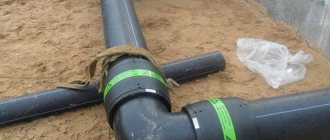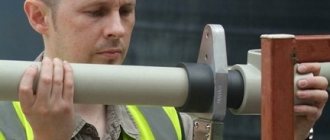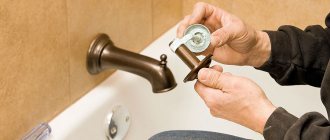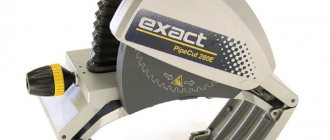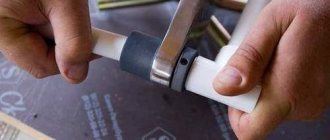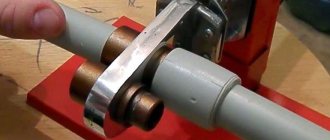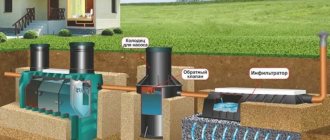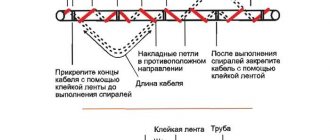Electric welding of water pipes is one of the most reliable ways to achieve the necessary tightness of the circulation circuit. The seams obtained using this technology are resistant to pressure, mechanical loads, and corrosion.
Unfortunately, even if all requirements are met, pipes may leak during operation. This occurs due to external loads for which metal structures are simply not designed, as well as due to natural aging and wear of the material.
In such a situation, you have to act immediately and eliminate leaks in an already used pipeline.
Selection of electrodes
Electrodes are the first thing you need to choose before you start welding pipes. The reliability of the seams and how tight the system will be, as well as the process itself, depend on their quality. The better the electrode, the easier the process will be.
An electrode is a thin steel rod, 0.2-0.5 cm thick, on which a special coating is applied to create a stable arc during welding. It also helps form the weld and prevents oxidation.
Electrodes are classified according to the type of core and type of coating.
According to the first point, electrodes are divided into two types:
- With a middle that melts. There is a wire inside, the thickness of which is selected depending on the type of welding.
- With a non-melting center. They are made from graphite, electrical coal or tungsten.
Example of graphite electrodes Source bvbalyans.kz
The coating on the electrodes can also be different:
| Shell | Brand | Characteristic |
| Pulp | C | Often used to connect to large cross-section pipes. Most often these are gas or water lines. |
| Rutile acid | R.A. | Used for welding heating or water pipes. When working with such an electrode, slag may appear, which can be removed by tapping on or near it. |
| Rutile | R.R. | These electrodes produce neat seams and a minimum of slag (and the stuck-on ones are easily removed). Most often used for corner joints or when welding subsequent layers. |
| Rutile-cellulose | R.C. | Suitable for any plane, often used to make long vertical seams. |
| Main | B | Universal electrodes are often used to connect thick pipes or parts that will be used at sub-zero temperatures. |
When selecting electrodes, it is important to remember that quality depends on price. If you purchase low-quality material, you may have to spend even more to redo it later.
Example of carbon electrodes with copper coating Source tk-gazmet.ru
See also: Catalog of companies that specialize in the design and installation of metal structures
Types of pipelines
Types of pipelines for water supply and heating systems:
- Steel, designed to supply water heated to +120°C at a pressure of up to 16 bar (depending on the wall thickness and diameter of the lines). They are easy to install, but have a service life of no more than 20 years.
- Steel with surface galvanization, have an increased service life. Operational parameters do not differ from those of pipelines without a protective coating.
- Copper, withstands heating up to +250°C and is resistant to plaque formation. For connection, soldering technology with special solders is used. The metal has a low coefficient of thermal expansion, parts do not deform when heated.
- Corrugated flexible hoses made of stainless steel. Allows you to connect heating equipment without the use of additional adapters and corner connections. The disadvantage is the use of rubber seals at the threaded connection points. It is impossible to weld stainless steel at home.
- Metal-plastic pipes designed for operation at temperatures up to +130°C and water pressure up to 10 bar. They are resistant to plaque formation and are not subject to corrosion. They have low mechanical strength and lose it under the influence of ultraviolet radiation. For connection, a special device is required for installing mounting rings. Soldering and welding are not used.
- Polypropylene pipelines designed for water pressure up to 20 bar at temperatures up to +95°C. They are resistant to mechanical stress and can withstand hydraulic shocks. For connection, a soldering iron with nozzles is used; in case of damage and leakage, the defective area is cut out. It is impossible to solder or weld polypropylene products.
Regardless of the material, pipelines are divided into categories according to purpose:
- technological, ensuring the supply of liquids used in the equipment;
- main lines, designed to deliver water to residential or office buildings;
- industrial, intended for supplying workshops with water;
- gas supplies used to supply natural gas to consumers;
- intra-apartment water systems, designed to drain liquid from the main riser to distribution points;
- sewer, ensuring the removal of contaminated liquid into a collector or sump.
Types of pipelines for water supply and heating systems.
Preliminary work
In order to qualitatively connect pipes by welding, it is necessary to carefully approach the surface preparation process. Since often when making a seam you have to work with old pipes, the first step is to clean the working surface of the metal until it shines so that there is no rust, paint or scale on the edges. The size of the cleaning surface must be at least 1 cm from the edge.
The edges of the pipes should be chamfered (grind off the edges at an angle of 65-70°) and leave a bluntness of 2 mm (the ungrinded part). After this, it is recommended to degrease the pipes at the welding site using chemicals, such as solvent, alcohol or their analogues. This will help create better adhesion (sticking) of the material on the working surface.
You also need to check the edges of the pipes for defects. Products with cracks or chips may not bond well, and when starting work, pressure or increased temperature may destroy the area with the damaged surface.
Example of a pipe with defects Source ural-meridian.ru
When welding, you should take into account the thickness of the walls of the material, since welding two pipes may be impossible or very difficult. It is necessary to carry out work between 2 surfaces of the same thickness, since a complete connection of thin-walled and thick-walled pipes will not be possible due to insufficient welding of the seam. Also, with this process, a thin pipe can be welded through, which will cause deformation or breakage at the joint.
When welding, you should also take into account the cut angle of the pipes. It should be 90°, since the seam will not be as strong, and this can lead to deformation or destruction of the joint. Also, when welding 2 pipes, it is easier to make a straight seam than a diagonal one, since it is more convenient and less time-consuming.
An example of a vertical seam on pipes Source teksa-s.ru
Self-production of the squeegee
If necessary, you can make a squeegee of the required size yourself. To complete the work you will need:
- metal steel pipe - a pipe cut of the appropriate length;
- carpenter's vice to make work easier;
- equipment for thread cutting: a die with a die holder for external threads or a tap for applying internal threads;
- file (intended for chamfering);
- grinder (metal hacksaw) for cutting, if you need to cut off a part of the pipe to prepare a pipe;
- lubricant
The work is performed in the following order:
- using a grinder or a hacksaw, the workpiece is cut to the appropriate length;
Types of seams and joints
There are several basic ways to weld pipes together:
- Butt joint is a method in which two parts must be opposite each other, for example, 2 ends of a pipe;
- T-joint or T-welding is the method most often used when cutting into a pipe. It involves connecting 2 pipes perpendicular to each other (in the shape of the letter “T”);
- Overlapping fasteners are used for a more hermetically sealed assembly of 2 pipes, as well as for small discrepancies in diameter or in the presence of irregularities. For such welding, one of the pipes is flared (the edge is enlarged using a special tool, stretching its surface from the inside) and its edge is put on the other end of the surface;
- Fillet welding is the process of joining 2 parts at different angles. Most often it is 45°, 60° or 90°.
Fillet welding example Source ad-cd.net
Heating
They installed biometallic radiators for me. So far they haven’t really given me any heat, but the house is rrrrrr. how cold it is. I consulted with you here. I installed steel pipes, not polypropylene. They also installed a bypass. But here’s a question for you. It seems like the plumber did everything well, he connected the system to check if there were any leaks. Basically, I had to do welding several times at the junction of the bypass to the horizontal pipes. And there such welding is almost as big as a fist and still flows. What is the reason? I also asked, but the water in the pipes will flow as much as possible, that is, is the pipe not narrowed with such welding? I was reassured. Here The other day I need to turn it off again and welding again. Well, I think maybe it’s doing something wrong, but I don’t understand this and am silent.
Masters online: 220 Orders per week: 2,306 Offers per day: 1,269
The whole reason is in the hands of the plumber. The slag from welding prevents him from welding well. Usually they are welded using gas welding, but it is a hundred pounds using electric welding. Hence the size of a fist.
At a construction site, for example, few people cook with gas, due to the cheapness of the electrode; maybe the plumber is just a mediocre cook?
Yes, it looks like he's not a very good welder. I would advise him to cut out this unit with a weld seam the size of a fist, and carefully weld a new one. There is a danger of endless welding of fistulas in this “fist”.
Good afternoon Alexander! It turns out that when you connect heating under pressure, there is a high danger of these fistulas or something. Now the pressure in the pipes without heating is low. I also thought, maybe paint several layers of paint, and if you cut it out, you’ll probably need a new pipe again. I’m with I’ll contact you on Monday, then the work will be half welded again and I’ll tell him what you said. But I’m very afraid that the pipes will burst, that is, the seams won’t hold up.
Of course yes, but I would advise using threaded connections if the person doesn’t know how to cook :-)
Elena, hello. No “maybe paint in two layers” - definitely, cut and digest. It is advisable to invite another welder. In this matter, savings are inappropriate. Repairs at your place, and probably at your neighbors’, will cost much more. Good luck.
an electrode in his mouth and two fingers in a socket.
We make with modern materials and don’t mess with welding. It’s one thing to weld new iron and quite another to weld it to rotten pipes. The problems with polypropylene pipes are certainly no more than with metal ones. Experience 13 years.
From the riser, the horizontal and bypass pipes are completely new, and the old ones were cut off by a plumber. Only I myself wanted such pipes, and not polypropylene. Sergey, you advised me, remember. I made steel pipes based on your advice.
Lenochka, you are confusing me with someone, we discussed the diagram of your system and how to clean it. After reviewing our correspondence, I did not find any advice to do it in metal. And in general, I’m not saying that metal is bad, it’s just that we make it in reinforced polypropylene. We haven’t been involved with welding for a long time for reasons like yours. Perhaps you didn’t have the opportunity to make it with polypropylene. The plumber knows best on the spot. Please do not confuse me with other Sergei.
I wonder if it's leaking or getting wet? It would be nice to show it with a photo. Electric welding will not break through phlegm. If you leave it, it may *take a long time*. But another welder is better, and you need good electrodes. I cook with Ano-36 electrodes. There are no problems. Very rarely it can freeze and it can be cooked under pressure. And the pipes are good. And it's good.
It’s leaking, yes, I paid this welder 14,000 thousand for such work, there is not even a contract, but if he has a conscience, if something happens, he must correct the defect. I will ask on Monday what electrodes he used to weld. I have now taken photos and will send them as a file.
This is what a welder did for me, where it is leaking.
Elena, if after the crossbars you put American joints or crossbars, then all the welding is visible and can be easily welded. Secondly, the jumper should be placed closer to the radiator and not closer to the riser. Third, you need to put a wet rag on the floor and then the parquet and linoleum will not be so dirty from welding. Fourth, it won’t break through 100%, it’s just not pretty. Fifth, I ask for 5000 rubles for such work. Usually they don’t pay money until it is verified that the work is good. It is very rare that something cannot be verified. They can't give me water. Today I changed the heating riser and left without checking. Sixth, such welding can be welded under pressure with a high current. If it doesn’t digest, there won’t be a flood. Keep calm.
Peter, thank you for your answer. Let's hope that there will be no worries about this during the heating season. Does it really matter that the jumper should be closer to the radiator? If this has already been done, then I'll see how it heats this winter. If it's bad, then next I’ll have to consult with you again on this forum for a year. I can see for myself what’s not done beautifully. But warmth is more important to me. I’m so tired of freezing in my Khrushchev apartment.
Yes, if they turn on the heating, everything will quickly dry out and tighten. But you can overcook it, of course.
Peter, what is “wonder”? If you overcook it, does that mean you have to cut it off first?
Of course, there is no danger of breaking through this seal. It will just be difficult for a welder to weld the place where it gets wet - where the scale sits is unknown, and the cycle “turning off the riser - boiling - starting the riser” can last forever. This overlap in the form of a massive seam was the result of a welder’s mistake in handling the tape measure: judging by the photo, in the upper horizontal pipe he burned a hole for the jumper a couple of centimeters closer to the cross than on the lower pipe. Then I burned another hole nearby and welded up the unnecessary one. What happened is not dangerous, and there is even significant hope that when the heating starts in October, the drops will boil by themselves. Reworking the work is possible only by your strong-willed decision, and the strict position “I will pay when there is no leakage.” Although this is not really necessary.
It will tighten - when there is heating circulation, the dirt from the inside will clog the leak or it will be sweating. This always happens. I started cooking like this 10-13 years ago. So Alexander Gordienko also confirmed that he would not break through. Keep calm.
Of course, purely from a human perspective, all that remains is to somehow console. And if, in fairness, the money was paid, then the work should have been done. Not with such a joint, not with a leak. And when they pay money and receive that they have to wait until the joint boils, in order to hide the terrible appearance, pour more paint and hang opaque curtains. Well, this is some kind of nonsense. Perhaps with such qualifications he also melted the inner diameter, not quite of course. But I think if you cut the joint, there will be good snot inside. To be fair, this city should be forced to be remade. Don’t reassure, like (oh well, live with it, others have had it worse, and nothing works). It shouldn't be like this, it's disgusting. And you can’t justify such things, it’s doubly disgusting. The best advice is not to put up with it, but to fight and get the result for which you PAID! Tomorrow, such a specialist will shit in ten more apartments, and he will get away with everything. Because a dozen people will say, okay, no big deal.
Thank you Igor for comforting me. I only posted some of the photos. In addition to these two welds, there is also something on the jumper when welding the “Duck” pipe to the radiator. There are generally 2 seams on the “duck” on horizontal pipes. I noticed after welding the radiators are attached crookedly .She told me to redo the work. I had to cut the pipes, and again make the second seam by welding. In short, the whole pipe was in seams. I agree that it was not done professionally. It just turned out to be a lesson for me that I couldn’t immediately find a professional in this matter. The job was done, and time will tell what the result will be.
rip off this welder's hands. It cannot be welded because when welding there is water in the pipe, it instantly boils in this place and pushes out the metal, cools it and prevents it from being welded. All the resulting clubroot must be cut off. drain the water from the pipe. and brew normally. You will only save yourself with paint if there is never any pressure in the pipe, so this option is impossible.
Why is it not possible? You need to know how. If you can’t cover all the water, it leaks a little. So what should I do? You can either brew it or simmer it. I want to ask you, did everything work out 100% well for you? Didn't anyone cut off their hands? 10-13 years ago my welding was bad. Right now it's 99% great. Sometimes it freezes, then I brew it under pressure.
Features of the welding process and small instructions
The first step when connecting two pipes is to secure them. They must be fastened so that during welding they do not diverge in different directions or are not pressed through by the electrode.
The welding seam must be made solid and continuous. To do this, do not tear the electrode off the surface of the material during work. But for pipes with a large diameter, this rule is not applicable, therefore, to connect such products, multilayer welding is used, in which the number of layers must be calculated based on the wall thickness.
Most often, for pipes with a thickness of 6 mm, 2 layers are used, for products with walls from 6 to 12, 3 layers are made, and for larger thicknesses, 4 or more layers are welded. Each subsequent seam must be made only after the previous one has been checked. You should wait until the connection has cooled completely, and then check it for defects.
An example of a multilayer welding seam Source yandex.net
If the thickness of the pipe walls is more than 4 mm, then a root weld can be made. Its peculiarity is that during welding the area between the surfaces is completely filled, without leaving a large weld on top of the seam. An analogue is a roller connection, in which a 3 mm roller remains above the surface of the pipe.
Since it is almost impossible to weld a pipe with water using electric welding, you should first turn off the water and drain it from the system. After this, you can begin the connection process. After completion of the work, it is recommended to conduct a test run to check the tightness of the seam.
When does it become necessary to weld pipes with water?
Welding of containers or pipes under water pressure is required when:
- detecting leaks at the joints of mains after putting the water supply system into operation;
- installing a section of pipe with a manufacturing defect (for example, a microscopic crack);
- repair of the pressure section responsible for the water supply to a house or several buildings;
- difficulties with draining liquid from tanks (for example, in inclined pipes or when installing pipelines in lowlands);
- a lengthy procedure for removing water from the system due to the increased volume (for example, it is not economically feasible to pump out 10-20 thousand liters of liquid due to a seam 20-30 mm long);
- the need to install additional fittings (for example, to install a branch).
Useful tips and possible mistakes
To do everything right right away and not redo bad work over time, you need to follow some tips:
- In hard-to-reach places, it is better to use a bent electrode and control the process using a mirror.
- If it is necessary to change the electrode, then the seam must be continued with a covering of 1-2 cm.
- Metal is heated better by electric current using direct polarity rather than reverse polarity.
Most often, defects arise due to the fact that inexperienced craftsmen are inattentive during work. In the case of welding, even a slight deviation of the seam will lead to the fact that it will not be tight and durable. If you change the arc length, voids and unwelded areas will form in the seams. Defects can also occur due to equipment or poor quality pipes.
An example of a poor-quality seam Source varim.by
Also, when welding, you must remember safety precautions:
- check the conductors and parts of the device, they must be insulated;
- the equipment housing must be grounded;
- all clothing, gloves and mask must be dry;
- before starting work, you need to put on rubber shoes or lay a rug made of this material under your feet, this will provide additional insulation;
- Be sure to wear a face shield to protect your eyes and face.
If you ignore safety instructions, you can get burns or electric shock.
After the welding work is completed, it is necessary to check the quality of the seam, since welding water pipes requires careful analysis. Externally, you can determine whether there are burns, pores, fistulas or other defects on the seams.
To check the seams for cracks, you must use a compressor. Plugs are installed at the ends, and the seams are coated with soap foam. After this, air must be pumped into the pipe under pressure. Soap bubbles will appear in places where the connection is not strong enough.
This is what scale looks like on a weld. Source ad-cd.net
Prices for welding heating water supply
- Log in to reply to this topic
#21 Georgiy 11
Please don't be rude to me, otherwise I'll press the complaint button
- Participant
- Messages: 10,660
- Orel city
- Top
- Insert nickname
#22 morgmail
I do this when I don’t cut or adjust anything, that is, everything is done by the customer’s mechanics. I'm just cooking.
Here, for example, it’s just stupid to hang 50 radiators and connect them, it costs a thousand for each, at least that’s what our mechanics charge, a thousand to hang and connect a radiator to a “flexible” (corrugated, metapol) liner. There are a couple more nuances: winter means there’s not much work, it’s not the time to gouge prices, and the customer is a frequent one, although he’s getting greedier every year.
- Top
- Insert nickname
#23 Dmitry N
- Moscow city
- Top
- Insert nickname
#24 Isperyanc
Dmitry N, and how much does 1cm cost you - is it always the same or different, for “up to 5 mm inclusive”?
- Top
- Insert nickname
#25 Shurpet
- Saratov city
Colleagues, indicate at least some amount so that we can understand the direction in advance.
- Top
- Insert nickname
Briefly about the main thing
The most important part in preparing for welding is choosing the appropriate electrode. They are different for each type of welding.
For highways, it is better to take one with a cellulose shell; for neat seams, it is advisable to take rutile and rutile-cellulose.
The main group is considered universal, but most often it is taken for use at sub-zero temperatures.
Before welding, you need to clean the surface to a shine, make a chamfer, degrease and check the pipes for defects.
For hard-to-reach places, it is better to use a bent electrode and monitor the process using a mirror. When changing the electrode, the seam should be overlapped by 1-2 cm.
To check the strength of the seam, you need to attach the pipe to the compressor, install plugs on both sides and lubricate the welding points with a soap solution. If there are cracks, bubbles will appear from them.
Ratings 0
Connecting a boiler to a double-circuit boiler, how is this possible
Those who live in a private house are forced to independently solve the problem of providing hot water. Typically, in private homes, the heating and hot water supply system is organized from a heating boiler, since in few places this is centralized. Hot water must flow simultaneously to both radiators and taps, so a boiler must be connected to the heating boiler.
What boilers are recommended to use?
For heating and organizing hot water supply, you can use double-circuit and single-circuit boilers with boilers.
If you have one or two distribution points in a private house, you don’t need a lot of water. In this case, the unit will be located inside the house and your choice is a double-circuit boiler.
Double-circuit boiler in the heating system
But to organize hot water supply and heating in a large, two-story house with a boiler room on the street, you only need a single-circuit boiler with a boiler. This will cost more, but if you organize hot water supply in a private residential cottage, do not skimp on it, you will still come to this decision.
Double-circuit boilers are not intended for several bathrooms, and they must also be located directly next to the place where water is used, otherwise heat loss will be large.
Advantages of a double-circuit boiler
If you want to set up hot water supply in a small private house or country house, then it is quite possible to use a double-circuit unit.
A double-circuit boiler produces 20 liters of hot water per minute. It is simple and economical. In order for there to be hot water in the house, you just need to connect a pipe with cold water to it, and then hot water will come out on the other side.
Double-circuit gas boiler with built-in boiler
There are units on sale with already built-in boilers. A double-circuit boiler with a built-in boiler will provide you with stable water heating and adjust the heating of your home. But, you need to understand that the volume of such a drive is limited by its functionality, it is small. Even in floor-standing boilers the volume does not exceed 150 liters, and in wall-mounted boilers it is even less.
In such configurations, the heating system is a secondary function, hot water takes the initial place and this is one of the disadvantages of this scheme. When hot water is used for its intended purpose, it will not flow into the heating pipes as a coolant. During this time, the temperature in the rooms may drop by several degrees, although this is not critical.
At the same time, it will not be possible to heat the water and put coolant into the heating radiators.
Additional connection of an indirect heating boiler
In those private houses where there is already a double-circuit boiler and it is not possible to change it to a single-circuit boiler, you can increase the amount of hot water by connecting an additional indirect heating boiler.
This is a more labor-intensive process; you may need additional devices that must control the flow of hot water and heating, because not all double-circuit units have them. It is quite possible to purchase such devices for connecting a boiler, but it is clear that such an installation will cost more.
A few years ago, such a connection was a problem, but now you can freely find a kit for combining two devices on sale.
By connecting an indirect boiler to a double-circuit boiler, you solve the problem of recirculation. That is, when you come home, you can turn on the tap and hot water will immediately flow from there. And if you live permanently in a private house, this is very important. And although a double-circuit boiler is cheaper, do not skimp on comfort; an indirect heating boiler is a must.
Installation Tips
Connecting the water heater to a dual-circuit thermoblock will occur in several stages.
Initially, you need to install a boiler, then connect all the devices into a single system and connect a double-circuit boiler.
The boiler and the boiler must be installed next to each other so that they can be connected by an automatic device. This connection will also require a circulation pump.
If you connect a boiler, the boiler must be gas or solid fuel, but not electric, otherwise the boiler will absorb a large amount of electrical energy, more than half. In this case, problems with heat will arise.
